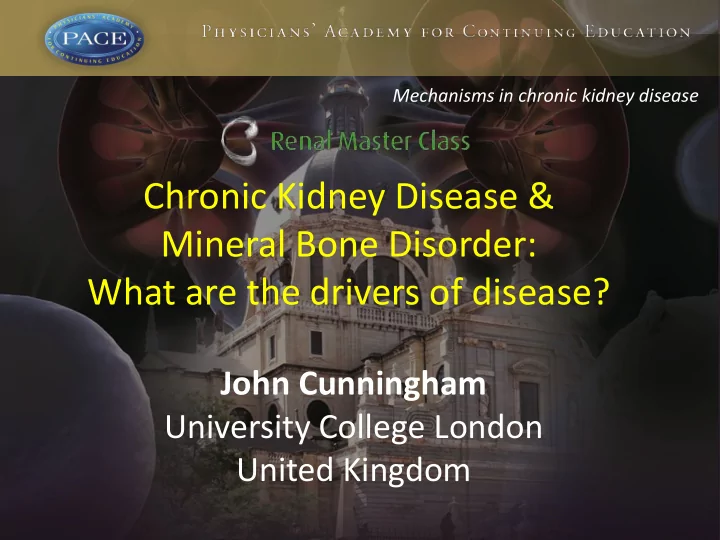

Mechanisms in chronic kidney disease Chronic Kidney Disease & Mineral Bone Disorder: What are the drivers of disease? John Cunningham University College London United Kingdom
Chronic Kidney Disease & Mineral Bone Disorder what are the drivers of disease? But which disease(s)?
Where is the initial “push” as GFR declines? At what are the early adaptive responses aimed?
Where is the initial “push” as GFR declines? At what are the early adaptive responses aimed? - difficulty maintaining phosphate excretion - difficulty making enough calcitriol
Phosphate: the achilles heel of therapies for CKD Ca x Pi calcitriol product dose hyperphosphataemia calcitriol dose PTH skeletal resist to PTH
Relationship Between GFR and TRP in Chronic Renal Disease J Clin Invest 1968
Effect of Dietary Phosphate Restriction on PTH 600 +6 CRD CRD Change in osteoclastic PTH ul eq/ml 400 resorption surface +4 +2 CRD-PPR 200 CRD-PPR 0 0 12 18 2 0 6 0 6 12 18 24 4 Months Months Rutherford, Slatopolsky et al
“Trade - off” Normal diet Pi restriction GFR GFR Pi Pi Ca ++ Ca ++ PTH PTH
Phosphate is a poor marker for SHPT in early CKD 21.6 1.50 Serum ionized calcium * * 1.25 16.2 pmol/L mmol/L * * * * 1.00 10.8 Phosphorus iPTH 0.75 5.4 0.50 0 0 Creatinine clearance (mL/min) Creatinine clearance (mL/min) Martinez I et al. Am J Kidney Dis 1997
Fibroblast Growth Factor-23 in Early Chronic Kidney Disease Evenepoel et al Clin J Am Soc Nephrol. 2010 5: 1268 – 1276
Progression of SHPT: parathyroid hyperplasia Single nodule Gland volume Nodular Early nodularity Secretory Diffuse Normal cells VDR CaR Normal Very high PTH Continuous functional demand Tominaga Y et al. Curr Opin Nephrol Hypertens 1996 Images courtesy of Dr D Pavlovic
Impaired calcium sensing in SHPT 110 100 90 80 PTH (%) 70 60 50 Set point 40 30 Severe SHPT 20 Moderate SHPT 10 Normal subject 0 0 4 4.4 4.8 5.2 5.6 6.0 6.4 mg/dL mmol/L 1.0 1.1 1.2 1.3 1.4 1.5 1.6 Ca ++ from Malberti F et al. Nephrol Dial Transplant 1999
Calcimimetic Compounds Increase the Sensitivity of the CaR to Calcium 100 H Control (1.0 mM) 10 nM (0.60 mM) N 80 F 3 C 100 nM (0.41 mM) •HCl (% of Maximum) CH 3 PTH Secretion 60 Cinacalcet binds in the trans- membrane region Ca 2+ 40 of the CaR 20 0 0 0.5 1.0 1.5 2.0 Extracellular Ca 2+ (mM) CaR Nemeth EF, et al. J Pharmacol Exp Ther. 2004
PTH-Ca curve obtained before and after calcimimetic therapy 2500 2000 n = 10 * • p < 0.01 1500 * * * * * * 1000 * * * 500 0 0.6 0.8 1.0 1.2 1.4 1.6 ionized calcium (mmol/L) de Francisco, Cunningham et al 2007
1,25-dihydroxyvitamin D not only a hormone kidney distant targets D 3 (hormone) (skin) 1,25(OH) 2 D 2/3 - gut - PT gland - bone PTH D 2 25(OH)D 2/3 (supplements) FGF23 local targets D 3 autocrine/paracrine 1,25(OH) 2 D 2/3 (diet) ‘ non classical ’ actions - immune system periphery - heart - vasculature - pancreas D 3 = cholecalciferol - tumours D 2 = ergocalciferol Redrawn from Heaney R
1,25(OH) 2 D 3 and 25(OH)D 3 deficiency and SHPT SEEK study Levin et al KI 2008
25-hydroxyvitamin D 3 suppresses PTH synthesis and secretion by bovine parathyroid cells Brown A et al Kidney International (2006) 70, 654 – 659
PT Injection with 22-oxacalcitriol Shiizaki et al J Am Soc Nephrol 16: 97-108, 2005
"Pulse" oral calcitriol - 4 weeks 8 3000 baseline 7 1100 o o 6 400 o • o o • 5 150 log e PTH PTH • o • (pg/ml) (pg/ml) • 4 o 55 • 3 20 • 1 month 2 7.4 1 2.7 - 0.25 - 0.15 -0.05 0 0.05 0.15 0.25 Ca ++ (mM) Cunningham Kidney Int 1999
Regulation of calcitriol production by phosphate Portale et al J Clin Invest 77: 7 1986
Regulation of calcitriol production by phosphate Portale et al J Clin Invest 77: 7 1986
Phosphate restriction/supplementation in paediatric CKD Dietary intake of phosphorus Normal Restricted Normal Supplement 80 60 1,25(OH) 2 D 40 (pg/mL) 20 P < 0.005 P < 0.01 0 400 120 100 PTH 80 (µLeq/mL) 60 40 20 P < 0.05 P < 0.05 0 Portale AA et al. J Clin Invest 1984;73:1580 – 9
Mineral Metabolism in CKD evolutionary changes pre and post Tp All these changes occur long before increases in serum Pi levels are evident <Dialysis> GFR time post Tp Modified from Wolf et al J Am Soc Nephrol 2010
after Cunningham 1999, modified Drueke 2011
Adaptive responses are often more striking than the initial perturbation
Adaptive responses are often more striking than the initial perturbation Adaptive (maladaptive) responses may be better surrogates for outcomes
Recommend
More recommend